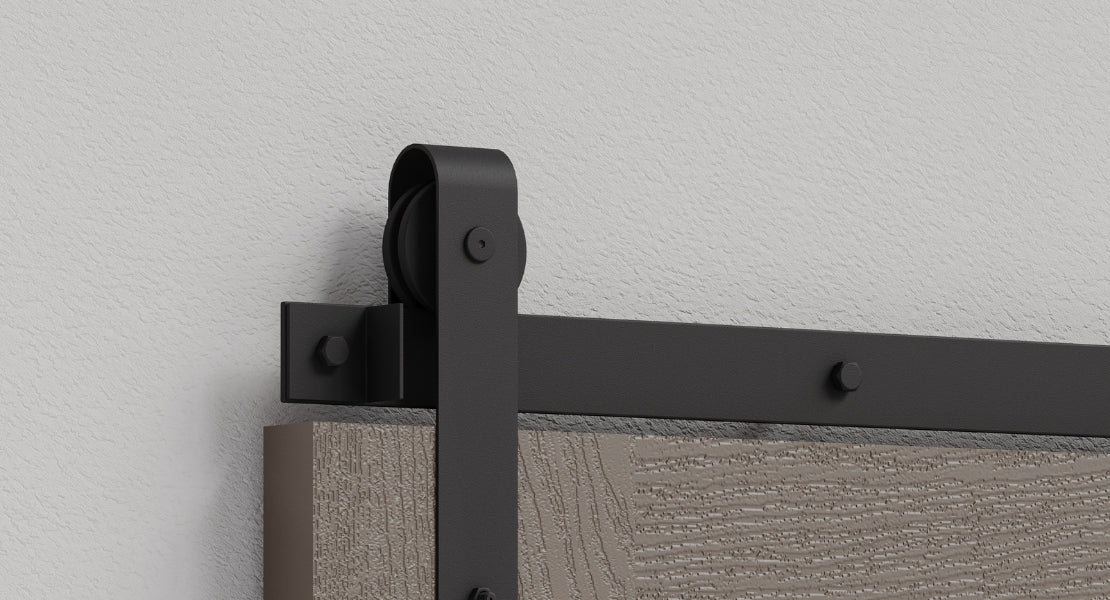
The 5-Minute Monthly Barn Door Maintenance Routine
Jessica thought she'd scored the perfect barn door setup. Beautiful reclaimed wood, premium hardware, professional installation—the works. For the first couple of years, that door glided like butter, becoming the centerpiece of her home office renovation.
Then the squeaking started.
"Just a little noise," she told herself. But within years, the door was grinding so loudly her calls got interrupted. One of the rollers had completely seized, gouging a permanent scratch in her expensive track. The repair bill? $650.
Here's the kicker: Jessica's entire ordeal could have been prevented with a 5-minute monthly routine costing about $20 per year in supplies.
The truth is, most barn door problems stem from neglect, not defective hardware. Natural issues that become more common with regular use, age, and environment.
Those "maintenance-free" claims from manufacturers? Marketing fiction. Even the best barn door systems need basic care (especially when you’ve had it for years) to prevent the $300-800 repair bills that blindside unsuspecting homeowners.
The good news?
Once you know what to do, keeping your barn door running smoothly takes less time than brewing your morning coffee.
What Happens If You Don't Maintain Your Barn Door?

Without regular maintenance, barn doors could develop squeaking, experience roller failure, or require complete system replacement costing $500-2,000, compared to just $20 annually in basic maintenance supplies.
The "set it and forget it" approach that manufacturers love to advertise simply doesn't exist in the real world. Sure, it may be designed in such a way that means these problems aren’t as prevalent for the first couple of years, but they’re not completely unavoidable.
Regular maintenance, even within any “maintenance-free” timeframes, will keep everything running smoothly for longer, and you’ll get a far greater lifespan without having to make half as many repairs or replacements.
So, here's what actually happens when you ignore basic barn door care:
Dust, pet hair, and microscopic debris accumulate in tracks, creating friction that announces itself through squeaking and grinding noises. That beautiful, smooth operation? Gone, replaced by doors that feel heavy and reluctant to move.
Dry roller bearings start to seize, creating flat spots on wheels that cause jerky, uneven movement. Track mounting screws work loose from constant vibration, leading to sagging that makes doors slide open by themselves. Wood doors begin showing signs of warping from humidity changes that proper maintenance would have prevented.
Complete roller replacement could run $200-400. Track realignment and remounting costs another $300-500. In worst cases, seized rollers damage tracks beyond repair, forcing complete system replacement at $1,000-2,500.
One contractor I spoke with put it bluntly: "I see more barn door failures from neglect than manufacturing defects. People spend thousands on beautiful doors, then won't invest ten minutes a month keeping them working."
The math is stark. Annual maintenance supplies cost roughly $20. Professional barn door repairs average $600. That's a 30-to-1 return on investment for basic preventive care.
How Do You Maintain a Barn Door in 5 Minutes Monthly?
Complete barn door maintenance in 5 minutes monthly by: 1) Visual inspection for loose screws and damage (1 minute), 2) Track cleaning with vacuum and damp cloth (2-3 minutes), 3) Strategic lubrication of roller bearings with silicone spray (1-2 minutes), plus a 30-second hardware tightening check.
This isn't about perfection—it's about consistency.
Five minutes of attention monthly prevents hours of problems and hundreds of dollars in repairs down the road.
Minute 1: What Should You Look for During Barn Door Inspection?
Start with a systematic visual inspection that catches problems before they become expensive. Use your phone's flashlight to illuminate track areas where shadows can hide developing issues.
Check these critical points: Look for loose screws in mounting brackets—they're usually the first to work free from daily vibration. Examine rollers for cracks, flat spots, or debris wrapped around axles. Inspect the track for sagging, especially at mounting points. Check door alignment by observing gaps when closed—uneven gaps indicate problems developing.
Red flags requiring immediate attention include any cracking in rollers or mounting hardware, visible rust or corrosion on metal components, doors that won't stay closed, or grinding noises during operation. These symptoms indicate problems that will worsen rapidly without intervention.
The key is developing a routine. Start at one end and work systematically to the other, spending about 15 seconds examining each major component. This systematic approach ensures nothing gets missed.
Minutes 2-3: How Do You Clean Barn Door Tracks Properly?
Track cleanliness directly impacts door operation and longevity. Even minimal debris creates friction that accelerates wear and creates noise problems.
The cleaning process starts with a vacuum using a brush attachment to remove loose debris. Pet hair, dust, and surprisingly large amounts of miscellaneous household dirt accumulate in tracks faster than most people realize. Follow vacuuming with a damp microfiber cloth, wiping the entire track length with particular attention to areas where rollers make contact.
What to avoid: Never use steel wool, abrasive cleaners, or pressure washers on barn door tracks. These damage protective finishes and accelerate corrosion. Skip oil-based cleaners that leave residues attracting more dirt.
Professional technique: Clean from one end to the other systematically rather than spot-cleaning problem areas. This ensures consistent track conditions and prevents missing sections that might cause problems later. For stubborn grime, a 50/50 white vinegar and water solution cuts through buildup without damaging finishes.
Minutes 4-5: What's the Best Way to Lubricate Barn Door Hardware?
Strategic lubrication represents the most critical maintenance step, yet it's where most homeowners make costly mistakes.
- The right approach focuses on roller bearings—the high-wear points bearing your door's entire weight. Apply one small drop of silicone spray to each roller bearing, then work the door back and forth to distribute lubricant internally. Wipe away any excess that might attract debris.
- Product recommendations include 3M Silicone Spray for general use and WD-40 Specialist White Lithium Grease for heavy-duty applications or extreme weather conditions. Both resist dirt attraction while providing long-lasting protection.
- Common mistakes to avoid: Over-lubrication attracts dirt and creates grinding paste that accelerates wear. Oil-based lubricants break down quickly and gum up over time. Never lubricate track surfaces where doors roll—this creates slippery conditions that can cause doors to slide unexpectedly.
- The 30-second hardware check completes your routine. Hand-tighten any loose screws without over-torquing. Pay special attention to track mounting bolts, roller assemblies, and floor guide screws—these critical fasteners bear the most stress from daily operation.
Does Barn Door Material Affect Maintenance Requirements?
Yes, barn door material significantly affects maintenance needs. Wood doors require humidity monitoring and finish protection, metal doors need corrosion prevention in humid climates, while glass doors need streak-free cleaning techniques and frame attention to prevent water damage.
Understanding your door's specific needs prevents material-related problems that generic maintenance misses.
How Do You Maintain Wood Barn Doors?
Wood doors bring natural beauty but demand extra attention to environmental factors. Humidity monitoring becomes critical—maintain indoor humidity between 30-50% to prevent swelling and warping. Seasonal changes hit wood doors hardest, so increase inspection frequency during spring and fall transitions.
Finish protection through light monthly applications of furniture polish prevents surface cracking and maintains wood's natural oils. Always apply polish in the direction of wood grain to avoid streaking. For painted wood doors, use mild soap and water instead of furniture polish, which can damage paint finishes.
Warping prevention requires consistent climate control and immediate attention to any signs of door movement. Slight seasonal expansion is normal, but progressive warping indicates moisture control problems requiring environmental adjustments.
What Special Care Do Metal Barn Doors Need?
Metal doors offer durability with minimal maintenance, but environmental factors can cause rapid deterioration without proper care.
Corrosion prevention starts with immediate drying after cleaning, especially in humid climates where moisture lingers on metal surfaces. In coastal areas, rinse hardware monthly with fresh water to remove salt deposits that accelerate corrosion.
Protective treatments applied yearly create barriers against environmental damage. Car wax works excellently for steel doors, while aluminum doors typically resist corrosion naturally with minimal treatment needed.
How Do You Maintain Glass Barn Doors?

Glass doors combine aesthetic appeal with straightforward maintenance requirements.
Cleaning technique uses standard glass cleaner or white vinegar solution applied with lint-free cloths. Work from top to bottom to prevent streaking, and clean frames before glass to avoid drips creating spots.
Frame attention prevents the water damage that destroys glass door systems. Ensure frames dry completely after cleaning, and address any seal deterioration immediately to prevent moisture infiltration.
When Should You Call a Professional for Barn Door Problems?
Call a professional for barn door issues when tracks pull away from walls, doors fall off tracks, or the same problem recurs despite proper maintenance. These indicate structural problems, safety hazards, or system failures beyond DIY repair capabilities.
Recognizing the limits of DIY maintenance protects both your investment and your safety.
- Structural issues requiring professional attention include tracks pulling away from walls, mounting hardware damage, or any situation where door weight exceeds the mounting system capacity. These problems typically stem from inadequate initial installation or building settling that requires engineering solutions.
- Safety concerns always warrant professional help. Doors falling off tracks, binding so severely they require force to operate, or hardware failures that create falling hazards need immediate expert attention. The potential for injury from heavy doors makes professional assessment essential.
- Repeated failures despite proper maintenance indicate underlying problems that DIY approaches can't address. When the same issue recurs monthly despite following maintenance routines, systematic problems require professional diagnosis and solution.
- Upgrade considerations become necessary when door weight exceeds hardware ratings, indoor hardware faces exterior conditions, or systems over 15 years old experience frequent problems despite maintenance. Sometimes the most cost-effective solution involves upgrading to modern, more maintainable systems.
Maintain once, enjoy forever.

Getting your barn door maintenance routine right from the start isn't just about preventing problems—it's about creating a system that operates flawlessly for decades with minimal effort.
The process is simple:
- Set your monthly reminder for the same day each month to build consistency
- Gather your supplies - vacuum, microfiber cloths, silicone spray (under $25 total)
- Follow the 5-minute routine - inspect, clean, lubricate, tighten
- Document any issues to track patterns and catch problems early
Five minutes monthly prevents thousands in repairs. You'll save money by catching small problems before they become expensive failures. You'll save time by avoiding the emergency repair cycle that disrupts your home and schedule.
Most importantly? You'll have a barn door system that glides like silk for 20-30 years while your neighbors deal with grinding, squeaking disasters and $600+ repair bills.
Shop barn door hardware today →
Five minutes monthly. Decades of perfection.


